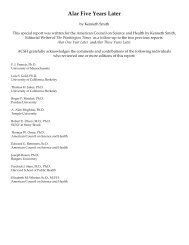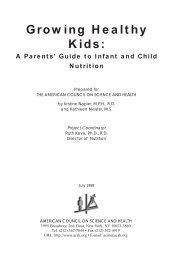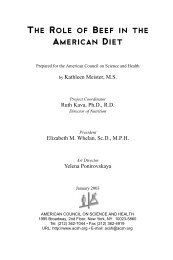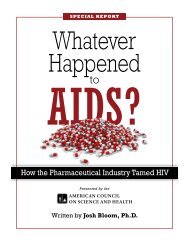Brominated Flame Retardants - American Council on Science and ...
Brominated Flame Retardants - American Council on Science and ...
Brominated Flame Retardants - American Council on Science and ...
You also want an ePaper? Increase the reach of your titles
YUMPU automatically turns print PDFs into web optimized ePapers that Google loves.
Studies Find No Health Risk<br />
At least four leading instituti<strong>on</strong>s – two internati<strong>on</strong>al,<br />
<strong>and</strong> two U.S.-based – have reviewed<br />
decaBDE for potential health risks to humans,<br />
<strong>and</strong> all four evaluati<strong>on</strong>s c<strong>on</strong>cluded that exposures<br />
to decaBDE were minimal <strong>and</strong> not likely to pose<br />
an adverse health risk. (Hays 2003) (CSOR 2004)<br />
Specifically, the World Health Organizati<strong>on</strong><br />
(WHO) evaluated the manufacture <strong>and</strong> formulati<strong>on</strong><br />
of decaBDE into polymers <strong>and</strong> c<strong>on</strong>cluded<br />
that exposure of the general populati<strong>on</strong> to<br />
decaBDE is insignificant. (WHO 1994) The<br />
Nati<strong>on</strong>al Academy of <strong>Science</strong>s (NAS) <strong>and</strong> the<br />
C<strong>on</strong>sumer Product Safety Commissi<strong>on</strong> (CPSC)<br />
assessed the use of decaBDE in textiles (Nati<strong>on</strong>al<br />
Academy of <strong>Science</strong>s 2000; Babich <strong>and</strong> Thomas<br />
2001), <strong>and</strong> the European Chemicals Bureau<br />
examined exposures to decaBDE via the general<br />
envir<strong>on</strong>ment. (ECB 2002) These four evaluati<strong>on</strong>s<br />
c<strong>on</strong>cluded that exposures via the respective pathways<br />
did not pose any adverse health risks to the<br />
general populati<strong>on</strong>. (Hays 2003)<br />
Additi<strong>on</strong>ally, the California Senate Office of<br />
Research (CSOR) reviewed the potential hazards<br />
from decaBDE <strong>and</strong> reached the following c<strong>on</strong>clusi<strong>on</strong>:<br />
Based <strong>on</strong> an analysis of the likely potential<br />
harm to humans posed by decaBDE <strong>and</strong> the<br />
known human exposures to this chemical, it<br />
does not appear that human exposure to<br />
decaBDE is occurring at a level that is likely<br />
to be unsafe for human health or development<br />
given the current level of scientific knowledge.<br />
At this time, it would be premature to<br />
add decaBDE to the list of banned PBDEs<br />
c<strong>on</strong>tained in AB 302 [a California law banning<br />
the sale of products c<strong>on</strong>taining two classes<br />
of PBDE – pentaBDE <strong>and</strong> octaBDE – as of<br />
2008]. (CSOR 2004)<br />
As for the exposure of infants <strong>and</strong> children to<br />
decaBDE, current levels of decaBDE in the U.S.<br />
are not likely to represent an adverse health risk<br />
for children (Figure 5). The study looked at six<br />
different pathways by which children might<br />
become exposed to decaBDE; it then combined<br />
these into three exposure scenarios, which aggregated<br />
all exposures for a given populati<strong>on</strong>: (Hays<br />
2003)<br />
1. Child (0–2 years) ingesting breast milk from<br />
a mother who manufactures decaBDE,<br />
mouthing decaBDE-c<strong>on</strong>taining plastic electr<strong>on</strong>ic<br />
products, mouthing decaBDE-c<strong>on</strong>taining<br />
fabric, <strong>and</strong> being exposed via the<br />
general envir<strong>on</strong>ment,<br />
2. Child (0–2 years) ingesting breast milk from<br />
a mother who disassembles electr<strong>on</strong>ics,<br />
mouthing decaBDE-c<strong>on</strong>taining plastic electr<strong>on</strong>ic<br />
products, mouthing decaBDE-c<strong>on</strong>taining<br />
fabric, <strong>and</strong> being exposed via the<br />
general envir<strong>on</strong>ment,<br />
3. Child (>2–18 years) being exposed via the<br />
general envir<strong>on</strong>ment. (Hays 2003)<br />
Like the findings of the WHO, CPSC, the EU,<br />
<strong>and</strong> the NAS, each of which c<strong>on</strong>cluded that<br />
decaBDE does not pose a health risk to humans,<br />
this assessment of the exposure of infants <strong>and</strong><br />
children in the U.S. to decaBDE was c<strong>on</strong>sistent<br />
with their c<strong>on</strong>clusi<strong>on</strong>s that current levels of exposure<br />
do not endanger the health of infants or children,<br />
including those ingesting breast milk from<br />
mothers occupati<strong>on</strong>ally exposed to decaBDE.<br />
(Hays 2003)<br />
German researchers furthermore found the<br />
reported levels of decaBDE detected in breast<br />
milk by Veith et al. (2005) would not be expected<br />
to be hazardous to infant health. There is a substantial<br />
margin of safety in the predicted intake of<br />
decaBDE by breastfeeding babies <strong>and</strong> EU st<strong>and</strong>ards.<br />
There is also a substantial margin of safe-<br />
Figure 5. Hazard Quotients for Children’s<br />
Exposure to DecaBDE<br />
Source: Hays 2003<br />
11










